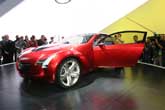Recent Articles
Popular Makes
Body Types
Car Brief: Mazda Kabura Concept
Firing a shot into the affordable sport coupe battle

Too much sun causes melanoma, a skin cancer that can be fatal if left untreated. In fact, Mazda has begun slapping warning labels reminding owners to use sunblock on the windshields of its MX-5 convertible as well as its cars, SUVs, and minivans equipped with a sunroof. If the Mazda Kabura Concept that debuted at the 2006 North American International Auto Show were to make it into production, it wouldn’t get that warning label, because it’s got a fixed glass roof over the front seats through which no UV rays can penetrate. That makes it just the thing for Miata owners tired of tanning but who love the open feeling of a roadster, and though the Kabura Concept is equipped with seating for four, it’s really a three-seater, unlike the larger RX-8 sports car that can carry a quartet of average-size musicians to their next gig. See, Mazda has designed the Kabura’s 3+1 interior so that the driver sits back within an angular cockpit environments complete with flat-bottom racing steering wheel and deeply hooded gauges. The front passenger’s area is stark in contrast, missing a glovebox so that the right front seat is moved forward of the driver’s positioning to make room for a bucket seat behind it. To gain access to the rear seat, the Kabura Concept has an extra-large opening on the passenger’s side that includes a conventional hinged door and a pocket door that slides into the rear quarter panel. Behind the driver is a jump seat worthless to adults, but when folded it creates a small cargo area that can be loaded from the driver’s door or through the two-piece glass hatch at the rear. The other two seats can fold, too, making enough room to carry a snowboard, according to Mazda. To keep weight down, the seats are upholstered in a mesh material that should also provide flow-through ventilation on warm days. The Mazda Kabura Concept’s design was penned by Franz von Holzhausen, who said: “Kabura…embodies several innovations Mazda implement when a compact sports coupe, steeped in is ready for production.” Since the Kabura Concept is built on modified MX-5 underpinnings, this missive seems to point to an upcoming coupe version of the MX-5. We hope Mazda keeps the Kabura name, which is taken from a Japanese word for a howling arrow that was traditionally used to signal the start of a battle. Do we foresee a Mazda Kabura vs. Nissan Edge comparison test five years out? Under the Mazda Kabura Concept’s long, shapely hood is a 2.0-liter, four-cylinder engine, just like the current Mazda MX-5. It powers the rear wheels through a six-speed manual transmission. Gigantic drilled brake discs clamped by silver-painted calipers shine from behind appealing five-spoke alloys. The Kabura concept includes a double-wishbone front and multi-link rear independent suspension setup, and this concept car rides on rear 20-inch wheels wearing 245/35R20 Bridgestone Potenza run-flat tires and front rubber featuring the same profile height and section width, but sized 19 inches. The Kabura Concept’s front wheels are stuffed under front fenders that look plenty like the RX-8 sports car – or even a Chevy SSR pickup. The traditional five-point grille gets a chrome garnish at the top like the 2003-05 Mazda 6, and there’s a clear panel running down the middle of the hood through which passersby can see the engine. Side character detail lifted from the RX-8 helps define the Kabura Concept’s bulging fenders, and the glass roof can go from clear to opaque to block out the sun. The glass also contains photovoltaic solar cells designed to keep the cabin cool on hot, sunny days and also to charge the battery. Sensually swelling rear fenders wrap around at the rear, where center-mounted exhaust outlets and a full-width taillamp panel decorate the Kabura Concept’s tail. This is a slick little ride, and if the Mazda Kabura Concept, or elements of it, become reality, Mazda will have one more performance product in its stable that personifies its design and engineering philosophy.
Photos by Ron Perry